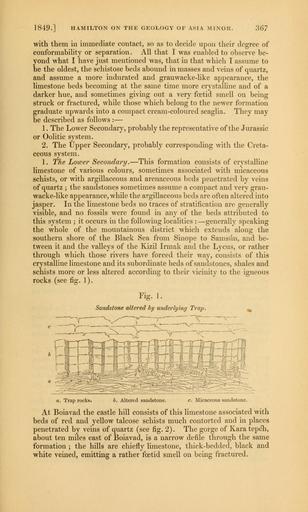MAKE A MEME
View Large Image

| View Original: | The_Quarterly_journal_of_the_Geological_Society_of_London_(12645216545).jpg (1203x1997) | |||
| Download: | Original | Medium | Small | Thumb |
| Courtesy of: | commons.wikimedia.org | More Like This | ||
| Keywords: The Quarterly journal of the Geological Society of London (12645216545).jpg 1849 <br> HAMILTON ON THE GEOLOGY OF ASIA MINOR <br> 'd 7 <br> with them in immediate contact so as to decide upon their degree of <br> conformabiHty or separation All that I was enabled to observe be- <br> yond what I have just mentioned was that in that which I assume to <br> be the oldest the schistose beds abound in masses and veins of quartz <br> and assume a more indurated and grauwacke-like appearance the <br> limestone beds becoming at the same time more crystalline and of a <br> darker hue and sometimes giving out a very foetid smell on being <br> struck or fractured while those which belong to the newer formation <br> graduate upwards into a compact cream-coloured scaglia They may <br> be described as follows ” <br> 1 The Lower Secondary probably the representative of the Jurassic <br> or Oolitic system <br> 2 The Upper Secondary probably corresponding with the Creta- <br> ceous system <br> 1 The Lower Secondary ” This formation consists of crystalline <br> limestone of various colours sometimes associated with micaceous <br> schists or with argillaceous and arenaceous beds penetrated by veins <br> of quartz ; the sandstones sometimes assume a compact and very grau- <br> wacke-like appearance while the argillaceous beds are often altered into <br> jasper In the limestone beds no traces of stratification are generally <br> visible and no fossils were found in any of the beds attributed to <br> this system ; it occurs in the following localities ” generally speaking <br> the whole of the mountainous district which extends along the <br> southern shore of the Black Sea from Sinope to Samsim and be- <br> tween it and the valleys of the Kizil Irmak and the Lycus or rather <br> through which those rivers have forced their way consists of this <br> crystalline limestone and its subordinate beds of sandstones shales and <br> schists more or less altered according to their vicinity to the igneous <br> rocks see fig 1 <br> Fig 1 <br> Sandstone altered by underlying Trap <br> a Trap rocks b Altered sandstone c Micaceous sandstone <br> At Boiavad the castle hill consists of this limestone associated with <br> beds of red and yellow talcose schists much contorted and in places <br> penetrated by veins of quartz see fig 2 The gorge of Kara tep«ih <br> about ten miles east of Boiavad is a narrow defile through the same <br> formation ; the hills are chiefly limestone thick-bedded black and <br> white veined emitting a rather foetid smell on being fractured 35269017 109512 51125 Page 367 Text v 5 http //www biodiversitylibrary org/page/35269017 1849 Geological Society of London NameFound Lycus NameConfirmed Lycus EOLID 110488 NameBankID 3002239 NameFound Sinope NameConfirmed Sinope EOLID 8898261 NameBankID 4344118 Biodiversity Heritage Library The Quarterly journal of the Geological Society of London v 5 1849 Geology Periodicals Smithsonian Libraries bhl page 35269017 dc identifier http //biodiversitylibrary org/page/35269017 smithsonian libraries Information field Flickr posted date ISOdate 2014-02-20 Check categories 2015 August 26 CC-BY-2 0 BioDivLibrary https //flickr com/photos/61021753 N02/12645216545 2015-08-27 10 57 07 cc-by-2 0 PD-old-70-1923 The Quarterly journal of the Geological Society of London 1849 Photos uploaded from Flickr by Fæ using a script | ||||